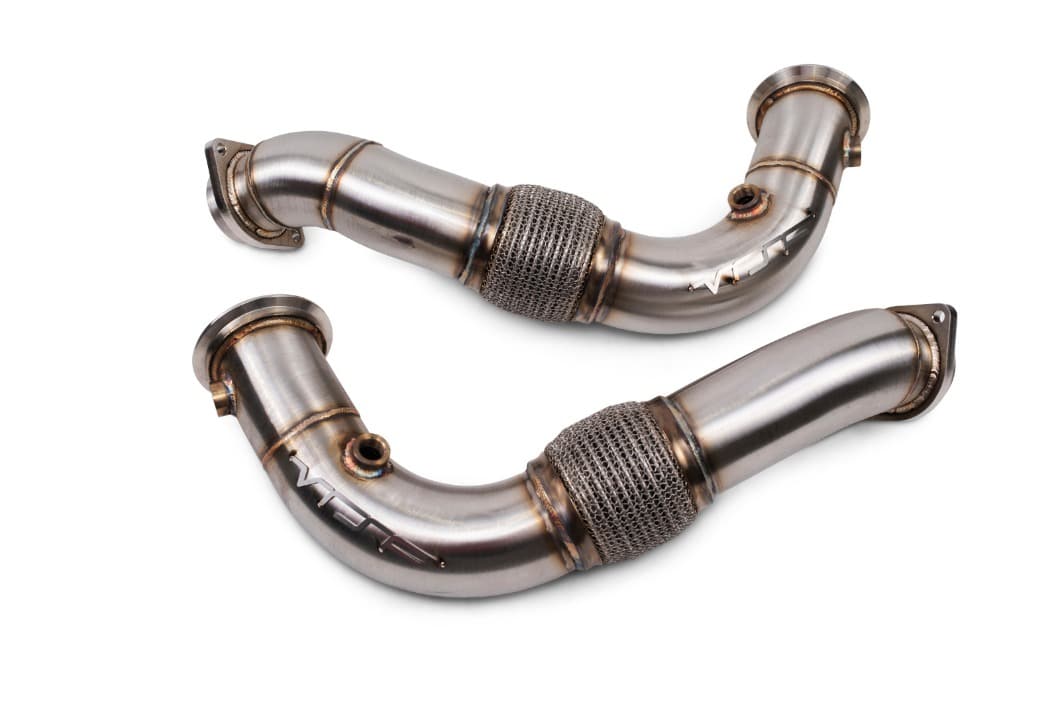When upgrading your turbocharged BMW, the catless downpipe N55 is one of the most impactful modifications you can make. It’s a favorite among enthusiasts for its ability to unleash horsepower, improve turbo spool, and transform the exhaust note into something more aggressive. But before diving into this mod, it’s essential to understand how a catless downpipe n55 works, what tuning is needed, and what sound characteristics you can expect.
What Is a Catless Downpipe for N55?
The N55 engine, featured in several BMW platforms like the F30 335i, F22 M235i, and F10 535i, comes with a restrictive factory downpipe that includes a catalytic converter. A catless downpipe N55 replaces this component with a free-flowing pipe that eliminates the restrictive cat, allowing exhaust gases to exit more quickly. The result? Better performance, sharper throttle response, and louder exhaust tones.
Why Choose a Catless Downpipe for the N55?
The catless downpipe N55 is one of the best bang-for-your-buck upgrades. Here’s why it stands out:
- Increased Horsepower and Torque: Removing the catalytic converter reduces backpressure, allowing the turbo to spool faster and more efficiently.
- Enhanced Turbo Sound: You’ll hear more turbo whistle and compressor surge.
- Improved Exhaust Note: A catless downpipe N55 gives your BMW a deeper, raspier, and more aggressive exhaust tone.
- Better Throttle Response: Less restriction equals quicker response when accelerating.
Tuning Is a Must
One of the most important aspects of running a catless downpipe N55 is proper tuning. Simply bolting it on without software adjustments can lead to check engine lights (CELs), poor drivability, or even engine damage.
Why Tune After Installing a Catless Downpipe?
- Eliminate CELs: Without a catalytic converter, the O2 sensors detect abnormal readings, triggering a CEL. A tune disables or adjusts the rear O2 sensor logic.
- Optimize Fuel Mapping: A proper tune recalibrates fuel and boost levels to take advantage of the added flow.
- Prevent Boost Creep: The increased flow from a catless downpipe N55 can cause overboosting if not properly managed.
- Unlock Power: Tuning ensures you’re getting the most performance out of your new setup.
Recommended platforms for tuning include Bootmod3, MHD, and JB4. Bootmod3 and MHD offer flash tuning capabilities, while JB4 is a piggyback system. For a catless downpipe N55, flash tuning is often the more reliable choice.
Sound Expectations with a Catless Downpipe N55
If you’re chasing a more aggressive exhaust note, the catless downpipe N55 delivers. Here’s what you can expect:
- Louder Startup: Cold starts become significantly more pronounced.
- Increased Volume Across RPMs: The exhaust is consistently louder throughout the rev range.
- Rasp and Crackles: Especially when paired with a performance midpipe or cat-back, your N55 will pop, burble, and crackle.
- Turbo Whistle: The removal of the cat enhances spool sounds and turbo flutter.
Do note that sound characteristics can vary depending on your exhaust setup (stock vs. aftermarket) and vehicle model. Also, running a catless downpipe N55 in a daily-driven car may attract attention due to the increased noise level.
Emissions and Legal Considerations
Installing a catless downpipe N55 is technically illegal in many areas due to emissions regulations. It eliminates a federally mandated emissions device, which can fail a visual inspection or OBD test.
To stay informed:
- Check your local emissions and inspection laws.
- Consider switching back to stock for annual inspections if necessary.
- Some owners opt for a high-flow catted downpipe as a compromise between performance and emissions compliance.
Best Practices for Catless Downpipe N55 Installation
Before installing a catless downpipe N55, follow these tips:
- Use Quality Parts: Invest in a reputable brand like VRSF, ARM Motorsports, or CTS Turbo.
- Upgrade Clamps and Gaskets: Avoid leaks by replacing worn gaskets and using high-quality clamps.
- Monitor Air-Fuel Ratios: Install a wideband O2 sensor or use tuning software to monitor AFRs.
- Plan for Tuning: Do not delay tuning after installation. Ideally, flash the tune immediately after the install.
Common Myths About Catless Downpipes on the N55
Myth #1: A catless downpipe N55 will instantly add 50+ horsepower.
Truth: Gains depend on supporting mods and tuning. Expect realistic gains of 20–30 hp with tune.
Myth #2: You don’t need a tune.
Truth: Tuning is crucial to prevent drivability issues and CELs.
Myth #3: It will always sound amazing.
Truth: Sound is subjective, and some setups may produce excessive rasp.
Final Thoughts
A catless downpipe N55 is an excellent upgrade if you’re seeking more performance and aggressive sound from your turbocharged BMW. With the right supporting mods and a proper tune, it can significantly enhance your driving experience. However, it’s important to weigh the legal and practical considerations—especially if your car is your daily driver.
Whether you’re hitting the track or just want to turn heads on the street, the catless downpipe N55 delivers results. Just be sure to plan your installation, get your tune dialed in, and enjoy the raw, turbocharged power that makes the N55 platform so rewarding to modify.










Leave a Reply